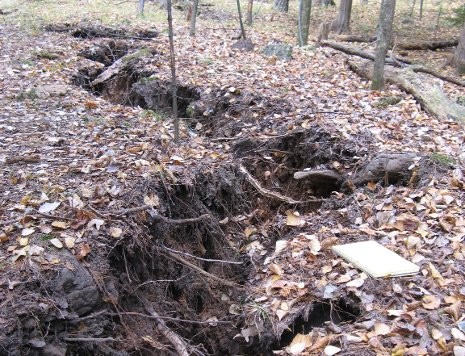By Ana Verayo, | February 11, 2016

The Menominee Crack opened up in October 2010 and now researchers from Michigan Tech have determined it is a geologic pop-up structure.
A strange sound erupted from the Earth in Michigan five years ago where scientists now have an explanation, calling this event a limestone bulge.
A deep, rumbling boom was heard thundering throughout the forest where rock and soil was exposed, revealing a massive crack near Birch Creek, in northern Menominee, located in the Upper Peninsula of Michigan. This weird sound was heard by locals nearby and shook their homes that measured a magnitude 1 earthquake on October 4, 2010 at around 8:30 A.M. local time. Local residents then discovered a long crack on top of a narrow ridge the day after they heard this ominous sound.
Like Us on Facebook
This massive crack measured 360 feet long and five feet deep, forming a ridge several feet high and 30 feet wide at its largest point. Trees were tilted from the side of this newly formed ridge, in the direction that was away from the crack, as exposed roots were torn apart from other trees which has been displaced on the opposite side of the crack.
According to senior author of the study, dean Wayne Pennington from the College of Engineering at Michigan Technology University, the crack seemed to ignore the roots, which means that the forces were more powerful than the roots.
During this seismic study, Pennington and his team believe that the most probable explanation for this newly formed ridge that uprooted trees is a "pop-up" originating from the upper layers of limestone under clay soil.
Researchers cannot identify the main source of this pop-up, however, they can now provide a better idea of the underground mechanisms that occurred during that time when the Earth cracked open, that was accompanied by a booming sound underneath.
As the teams surveyed the underground rock, they created sound waves using a sledgehammer as they slammed this sledgehammer into a metal ball that was placed on top of the ground, tracking how soundwaves travelled through the layers of soil below.
The results revealed a sharp buckle within the milestone just below the crack. This also explains how the bedrock limestone was violently pushed upwards towards the Earth above when this pop-up appeared that displaced the overlying clay soil.
This clay soil layer is about five feet deep along the ridge as the crack was produced from the stretching of this surface clay that was bent upwards. The team also concluded with their survey that the crack was not produced by an earthquake fault under this ridge, as only a strong earthquake can only move rock and soil layers vertically over several feet, adds Pennington.
This new study is published in the journal Seismological Research Letters.
-
Use of Coronavirus Pandemic Drones Raises Privacy Concerns: Drones Spread Fear, Local Officials Say

-
Coronavirus Hampers The Delivery Of Lockheed Martin F-35 Stealth Fighters For 2020

-
Instagram Speeds Up Plans to Add Account Memorialization Feature Due to COVID-19 Deaths

-
NASA: Perseverance Plans to Bring 'Mars Rock' to Earth in 2031

-
600 Dead And 3,000 In The Hospital as Iranians Believed Drinking High-Concentrations of Alcohol Can Cure The Coronavirus

-
600 Dead And 3,000 In The Hospital as Iranians Believed Drinking High-Concentrations of Alcohol Can Cure The Coronavirus

-
COVID-19: Doctors, Nurses Use Virtual Reality to Learn New Skills in Treating Coronavirus Patients







